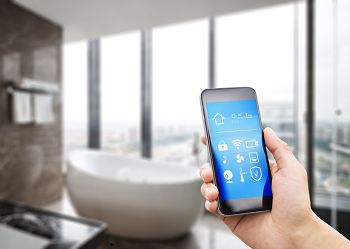
The cost of HVAC systems and energy has prompted equipment manufacturers to create more product efficiency. Smart HVAC systems are a positive step forward in achieving this goal. Residential, commercial, and industrial customers appreciate the reduced electrical costs associated with operating their systems. Contact ITI Technical College today to learn more about the rise of smart HVAC systems.
Smart technologies, including the Internet of Things (IoT), let users adjust temperature, humidity, and air quality remotely for convenience and savings. These smart systems use sensors and data analytics to optimize energy efficiency, reduce costs, lower their environmental impact, and improve system reliability. Today’s technicians are trained to install and maintain these systems for optimum performance.
IoT Transformations
The IoT has produced technologies that are transforming HVAC efficiency and user control. IoT is a means of connecting HVAC solutions to enhance the operations of devices, equipment, and systems. There are other benefits of IoT technologies, including:
- Predictive maintenance solutions provide early detection of potential failures.
- Downtime and maintenance costs are reduced through predictive maintenance.
- Using renewable energy sources moves HVAC systems closer to sustainability.
- Less reliance on fossil fuels lowers greenhouse gas emissions.
- Energy recovery ventilation systems recuperate and use waste heat for efficiency.
- Energy analytics and management tools optimize performance and reduce energy use.
Using smart HVAC systems led by IoT transformations is an industry and consumer win-win situation. More efficiency is achieved while improving the convenience in user control of heating, cooling, ventilation, and refrigeration systems.
Efficiency In Smart HVAC Systems
 The growth of current HVAC trends includes increasing the efficiency of equipment and lowering operating costs. Smart systems are superior because they use real-time data to adjust heating and cooling settings to maintain comfort without wasting energy, and also provide:
The growth of current HVAC trends includes increasing the efficiency of equipment and lowering operating costs. Smart systems are superior because they use real-time data to adjust heating and cooling settings to maintain comfort without wasting energy, and also provide:
- Air quality is achieved with air purification components that adjust airflow based on air quality readings.
- Intelligent learning in smart systems understands usage patterns and adapts accordingly, and turns heating and cooling on and off as needed.
- Optimal performance is achieved by monitoring and adjusting system components to ensure they operate at peak efficiency.
- Precise control is obtained by using sensors and algorithms to adjust temperature and humidity based on the number of people in a room, the weather, and the time of day.
- Real-time data is used to analyze conditions rather than following a less efficient schedule. Real-time data allows devices to make small adjustments as needed instead of running longer than necessary or idling for too long.
All these components in highly efficient and automated HVAC systems help save money on energy bills. A smart system can also make a home more marketable to potential buyers.
|
“Smart technologies including the Internet of Things (IoT) let users adjust temperature, humidity, and air quality remotely for convenience and savings.” |
User Control In Smart HVAC Systems
User control of HVAC systems has vastly improved with smart systems. Connectivity is the key with features such as cellular control, geofencing, and voice activation. With them, users gain immediate control over their HVAC systems. Integrating IoT platforms provide a range of capabilities from remote monitoring to sophisticated programming. Smart HVAC systems provide users with a variety of ways to control heating, cooling, and ventilation, including:
- Remote control devices allow users to control their systems with a mobile app, web interface, or voice commands when outside the house or away from home.
- Learning capabilities include learning from user preferences and habits over time to anticipate temperature and comfort preferences.
- Indoor air quality can be monitored and alerts for taking corrective action posted.
- User interface technologies are convenient and easy to use, such as pushbutton and touch-screen controls, keypads, and system controllers.
- Motion sensors are used to adjust settings based on room occupancy.
Smart HVAC systems improve energy efficiency as well as user comfort. For example, the system can be set to provide a temperature during the day and a different one at night. It can be programmed to turn the temperature up or down a short time before leaving and getting back home.
More Benefits Of Smart HVAC Systems
 Smart HVAC systems can save up to 20% on home and business energy bills. The energy efficiency leads to a smaller carbon footprint and less air pollution. Remote troubleshooting and diagnosis of commercial and industrial systems is now possible to identify malfunctions before sending out repair technicians. Advanced systems let technicians know the components and equipment to take to the job site to shorten repair time. The rise of smart HVAC systems and IoT is transforming HVAC efficiency and user control to everyone’s delight.
Smart HVAC systems can save up to 20% on home and business energy bills. The energy efficiency leads to a smaller carbon footprint and less air pollution. Remote troubleshooting and diagnosis of commercial and industrial systems is now possible to identify malfunctions before sending out repair technicians. Advanced systems let technicians know the components and equipment to take to the job site to shorten repair time. The rise of smart HVAC systems and IoT is transforming HVAC efficiency and user control to everyone’s delight.
If you are interested in an HVAC career check out the Air Conditioning, Refrigeration, & Electrical Technology (AOS) Associate In Occupational Studies Degree at ITI Technical College in Baton Rouge.
For more information about graduation rates, the median debt of students who completed the program, and other important information, please visit our website: https://iticollege.edu/disclosures/




